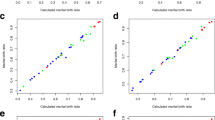Abstract
Earlier studies have pointed out that socio-economic differentials in fertility depend upon both religion and farm background. These studies report a negative relation between fertility and socio-economic status for non-Catholic American couples in contrast to a positive relation for Catholics. Likewise, a negative differential for American couples with farm background has been observed in contrast to no differential for twogeneration urbanites. Age at marriage is a third such interaction variable: the strong negative socio-economic differential observed when wife’s age at marriage is under 19 diminishes with advancing age at marriage and becomes positive for wives who married at age 23 or older. Moreover, for both non-Catholics and Catholics, couples with and without farm background, the differential by wife’s education is negative when wife’s age at marriage is young, positive when her age at marriage is old. Both sociological factors (the incidence of non-familial adult roles) and differential fecundity appear to underlie the interaction. The analysis is based on reports of once-married, white, nonfarm wives aged 30 to 39 included in the 1955 or 1960 Growth of American Families Studies or the 1965 National Fertility Study (approximately 1,000 in each survey).
Similar content being viewed by others
References
Blake, Judith. 1967. Income and reproductive motivation. Population Studies 21: 185–206.
Bumpass, Larry. 1968. Age at Marriage as a Variable in Socio-economic Differentials in Fertility. Unpublished Ph.D. dissertation, University of Michigan.
Duncan, Otis Dudley. 1965. Farm background and differential fertility. Demography 2:240249.
Freedman, Ronald, P. K. Whelpton, and A. A. Campbell. 1959. Family Planning, Sterility, and Population Growth. New York: MeGraw-Hill.
—, and Doris Slesinger. 1961. Fertility differentials for the indigenous non-farm population of the United States. Population Studies 15:161–173.
—, D. Goldberg, and L. Bumpass. 1965. Current fertility expectations of married couples in the United States: 1963. Population Index 31:3–20.
Goldberg, David. 1959. The fertility of twogeneration urbanites. Population Studies 12: 214–222.
—. 1960. Another look at the Indianapolis fertility data. Milbank Memorial Fund Quarterly 38:23–36.
—. 1965. Fertility and fertility differentials, some observations on recent changes. In Mindel C. Sheps and Jean C. Ridley (eds.), Public Health and Population Change. Pittsburgh: University of Pittsburgh Press.
Pratt, Lois, and P. K. Whelpton. 1958. Extrafamilial participation of wives in relation to interest in and liking for children, fertility planning and actual and desired family size. In P. K Whelpton and C. V. Kiser (eds.), Social and Psychological Factors Affecting Fertility. New York: Milbank Memorial Fund.
Ridley, Jean C. 1959. Number of children expected in relation to non-familial activities of the wife. Milbank Memorial Fund Quarterly 37:277–96.
Ryder, Norman B., and C. F. Westoff. 1966. Use of oral contraception in the United States. Science 153:1199–1205.
—, and C. F. Westoff. 1967. The trend of expected parity in the United States: 1955, 1960, 1965. Population Index 33:153–168.
United States Bureau of the Census. 1964. United States Census of Population: 1960. Subject Report: Women by Number of Children Ever Born. Final Report PC(2)-3A. Washington: Government Printing Office.
Westoff, Charles F., R. Potter and P. E. Sagi. 1963. The Third Child. Princeton: Princeton University Press.
Whelpton, P. K, A. A. Campbell, and J. E. Patterson. 1966. Fertility and Family Planning in the United States. Princeton: Princeton University Press.
Author information
Authors and Affiliations
Rights and permissions
About this article
Cite this article
Bumpass, L. Age at marriage as a variable in socio-economic differentials in fertility. Demography 6, 45–54 (1969). https://doi.org/10.2307/2060099
Issue Date:
DOI: https://doi.org/10.2307/2060099




